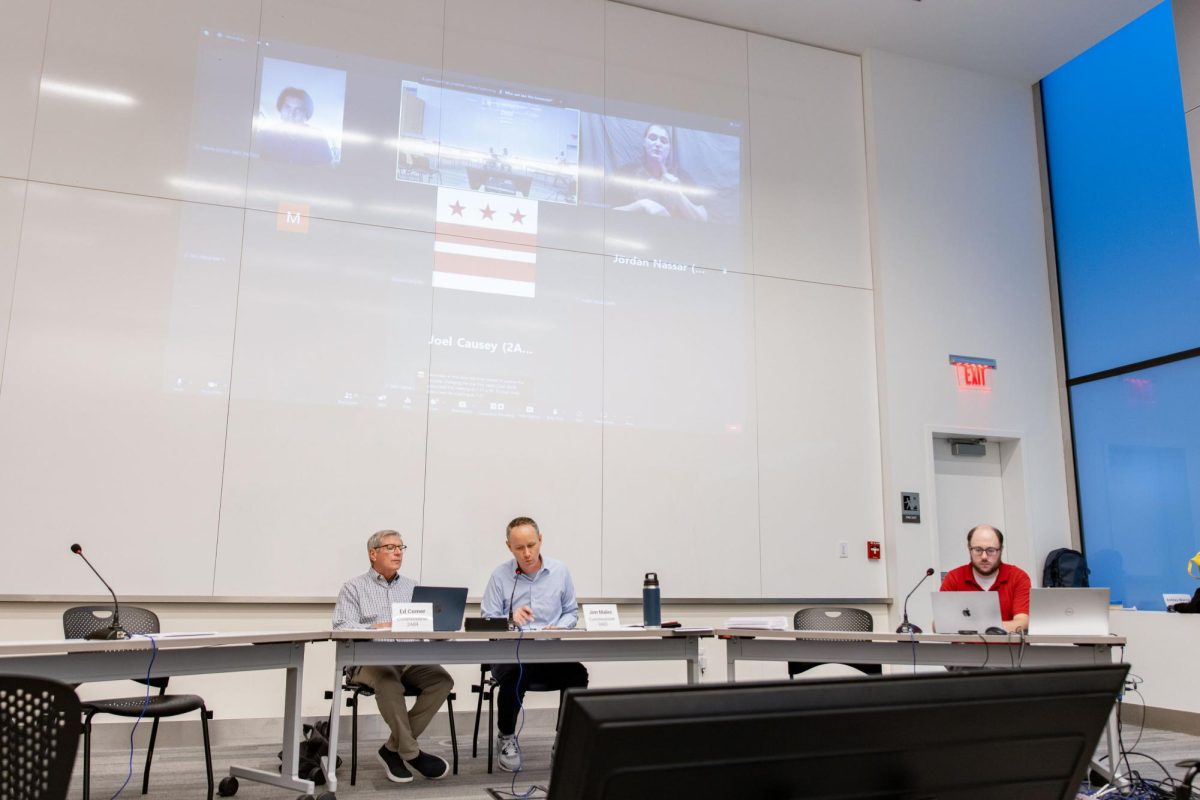Nurses at GW Hospital allege officials are unfairly dissuading them from unionizing as the group adapts new organizing efforts while they inch toward a union vote.
District of Columbia Nurses Association Staff Attorney Kenneth Page alleged earlier this month that hospital management has removed pro-union signage, put glass frames over bulletin boards in the hospital to prevent union representatives from posting material and held meetings where they dissuaded nurses from unionizing. Nurses said the longer they wait for a National Labor Relations Board ruling allowing them to vote to unionize, the more time the hospital has to deter nurses from joining the union effort.
Page said without space to advertise the union inside the hospital, union organizers began advertising the benefits of unionizing in chalk art, with slogans like “Patients Over Profits” on the pavement outside the hospital and flyers posted near the Foggy Bottom Metro station. He said union representatives table outside the hospital to answer any questions nurses might have three times per week.
“We’ve been adjusting our strategy to our lack of access,” Page said. “We’re doing town halls over Zoom.”
Page said he refiled two unfair labor practice complaints last month, which replace the four complaints he filed on behalf of GW Hospital nurses in March and contain more than 15 allegations of unfair labor practices, including officials removing union promotional material at the hospital. Page said he withdrew the four complaints and refiled two others to better organize the allegations, which the NLRB approved in early April.
“There’s been a lot of real aggressive, negative union language in the space,” Page said.
Page said one of the refiled cases contests the hospital’s “unfair dismissal” of registered nurse Angelo Estrellas, which DCNA claimed in a March release was because of his involvement in organizing a union at the hospital. A petition to reinstate Estrellas has more than 2,300 signatures as of Saturday.
“We believe they fired him without cause,” Page said.
A GW Hospital spokesperson declined to comment on the complaints.
Page said Estrellas’ dismissal had a “chilling effect” on nurses, discouraging them from publicly advocating for the union.
“In a union-organizing campaign, you can’t make any promises or things that can be identified as attacks or threats on your employment,” Page said. “And we believe that they have crossed the line and some of the things they are doing are, in fact, that.”
Edward Smith, DCNA’s executive director, said the hospital contested Estrellas’ unemployment benefits, which DCNA appealed.
He said NLRB held a hearing April 12 to decide whether certain employees are eligible to participate in the union vote, which is delaying the union from scheduling the election. He said union representatives should hold the vote within 12 days of NLRB’s written decision on whether to include the employees, but he does not know when the decision will come.
“The legal process takes time and requires a lot of patience,” Smith said.
Stefanie Alarie, a registered nurse at GW Hospital, said Estrellas’ suspension “ignited” more of a fire on nurses’ existing efforts to unionize. She claimed hospital management sent “spies” to a union event outside working hours offsite, which led hospital management to discover Estrellas’ involvement in the union and suspend him.
She said before management discovered Estrellas’ ties with the unionization effort, his manager sent him to find more information on it.
“Before he was found out to have been helping out with union efforts, he himself was sent by his manager to go see if he could find that they know,” she said.
Alarie claimed the hospital removed union signs from breakroom tables, bulletin boards, locker rooms and nearby light posts and parking garages “at any opportunity that they have,” and managers make comments to nurses about how their involvement in a union will estrange them from management. She said delays in setting a date for a union vote give hospital management more time to dissuade nurses from unionizing.
“Every day that passes that we’re waiting for our election day just gives them another chance to strengthen their anti-union front,” Alarie said.
Alarie said nurses officially contacted DCNA about a potential union at the end of last summer. She said nurses hope to see improved patient-to-nurse ratios informed by the seriousness of patients’ afflictions to protect patient safety.
“We can talk all day about having safer ratios, but it needs to be enforced,” Alarie said.
A registered nurse who wished to remain anonymous because of fear of retaliation from hospital management said hospital administrators wear pins with the word “union” struck out and discarded promotional stickers on bags of cookies union representatives sent.
“They are very outright about their anti-union stance, and they are very critical of those people who are in support of the union,” the nurse said.
The nurse said the hospital’s display of its anti-union stance has made some nurses scared of being fired because Estrellas’ termination showed that management views nurses as “disposable” and “replaceable.”
“They’re scared, and they are also unsure of really who to trust,” the nurse said.
The nurse said the resident physicians’ vote at the School of Medicine and Health Sciences to unionize late last month boosted nurses’ morale because residents are “hugely supportive” of nurses’ unionization efforts.
The nurse said before the pandemic, the hospital utilized a ratio of one nurse for every five patients. The nurse said the hospital later implemented a pilot program adjusting the ratio to one nurse for every six patients, which became the norm.
The nurse said the hospital did not provide ancillary staff or technicians to support nurses with more patients when they made the ratio shift. The nurse said although the patients they worked with mostly did not require critical care, the shift in the nurse-to-patient ratio increased nurses’ responsibilities and made them further unable to care for their other patients if any of their patients had an emergency.
“When your one patient has an emergency, your four or five other patients are essentially not being able to be cared for imminently while you deal with the emergency because that patient that is sick has now taken up all of your attention,” the nurse said.







